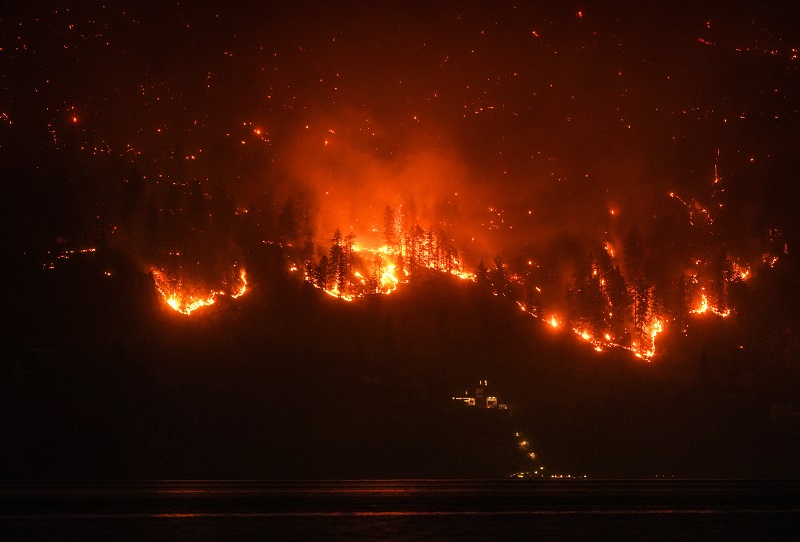Night once brought firefighting reprieve, but no longer, Canadian study shows

BRITISH COLUMBIA — The darkness of night has traditionally signalled reprieve for wildland firefighters, but a new Canadian study shows that’s changing, and drought is the driving force.
The availability of bone-dry fuels is the key mechanism promoting extreme fire behaviour and growth at night, the study says, though warming temperatures are also eroding the “climatological barrier” that has typically limited overnight burning.
Uncovering the role of drought led the researchers to further show that daytime conditions can be used to predict whether a fire will continue to burn and possibly spread through the night — information that could be crucial for firefighting efforts.
“We have fire growth models, and they handle the day really well most of the time, and that’s usually the most important part. But they don’t really do well at night,” says Mike Flannigan, one of the study’s co-authors in British Columbia.
“Any kind of information of how active a fire will be at night is really critical … especially if a fire is approaching a town, like West Kelowna last year,” he says, recalling a fast-moving blaze that began tearing through part of the Okanagan community one evening last August, ultimately destroying nearly 200 homes.
Wildland firefighters work overnight in such situations, when flames are threatening people and infrastructure, Flannigan says. It’s not standard policy for most blazes, and traditionally, nighttime reprieve is “almost relied upon as a given,” he says.
The study, published Wednesday in the peer-reviewed journal Nature, suggests that is an increasingly risky bet as climate models predict summers will get hotter and drier, conditions that Flannigan describes as a “powder keg” for wildfire.
Canada’s drought bulletin shows pockets of “exceptional” and “extreme” drought in central B.C. and southern Alberta, while drought conditions in swaths of both provinces were classified as moderate to severe at the time of the Feb. 29 update.
“If I were looking towards this summer, I’d be worried about overnight burning,” says Flannigan, a professor at Thompson Rivers University in Kamloops and the B.C. research chair in predictive services, emergency management and fire science.
The study used wildfire records and satellite data to examine more than 23,500 blazes across North America from 2017 to 2020. The researchers identified 1,095 overnight burning events associated with 340 wildfires and found the vast majority spanned at least 10 square kilometres.
The paper says the driving forces were the dryness and availability of forest fuels, such as grasses, fallen leaves, twigs and branches.
The research led by Kaiwei Luo at the University of Alberta also found that overnight burning often occurred within two days of ignition.
That’s significant, Flannigan says, because it’s a crucial time for rallying firefighting resources with the goal of containing flames before they spread.
The study further found that 85 per cent of all overnight fires burned for consecutive days or even weeks at a time.
The researchers didn’t stop at linking drought with overnight burning. They also developed models to explore whether it could be predicted, a potentially powerful tool, and found daytime conditions set the stage for what happens at night.
“That day, you can say, ‘this is a high likelihood of burning through the night,’ and prepare accordingly,” Flannigan says of the new modelling.
Flannigan works closely with the predictive services arm of the BC Wildfire Service and says the researchers will provide their model in hopes of testing it this summer.
“Not every year is going to be a bad fire year. Some years are going to be cooler, some years are going to be wetter,” he says. “But on average, we’re going to see hotter, drier summers, which leads to conditions more conducive to fire.”
“We should be looking at … daytime and nighttime firefighting,” he says. “Rather than being a rare, or infrequent occurrence, which will become much more common.”
B.C. has yet to update it’s drought information portal this year, but the final update from November shows much of northern B.C. in severe drought, and snowpack throughout the province has been lower than normal all winter.
This report by The Canadian Press was first published March 13, 2024.







